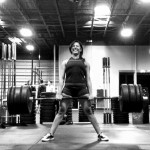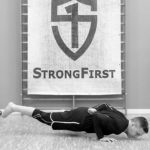Years ago, after a Plan Strong™ seminar, I had a chance to ask Pavel a question.
Me: “What do you think the biggest issue is in the fitness industry?”
Pavel: “I don’t have enough time to answer that question, but I will tell you that there is far too much entertainment.”
I understood exactly what he meant. Real work isn’t entertaining. It’s work. It’s hard. It takes focus. It’s not flashy lights and watching your heart rate on a TV screen. However, I also understand why the fitness industry continues to do such things. If they can try to make it fun, maybe people will stick with it.
Although there are indeed athletes that train by themselves as well as many coaches who train clients one-on-one, the group fitness model isn’t going anywhere anytime soon. Group classes don’t need to be flashy or overly entertaining. I have found that building a strong community with smart, consistent programming in a group class model is indeed possible. We’ve been doing it for a little over a decade at Axistence Athletics.

In this article, I’m going to share how I developed an 8-week strength program for a group class setting, using an average relative intensity (ARI) of 75.4% inspired by Plan Strong’s principle which states that this zone is the main intensity zone for lifters who want to increase strength and gain muscle mass.
This program helped 29 of our members set 61 new personal records. While it’s possible that some of these numbers could be chalked up to “beginner’s gains,” we also saw men and women in their forties and fifties who hadn’t lifted this much weight since their college days. And each member who set a new PR had been lifting for at least two years.
If you’ve been around the fitness industry for a while, you’ve likely heard a coach say: “The best program is the one that you will follow.”
While it’s true that consistency delivers results, results are only as good as the program. If you want to get strong, but your program is weak, then it’s not the best program.
Over the last decade I’ve co-owned and operated Axistence Athletics, a gym in Southeast Denver. During that time, we’ve continuously tweaked and evolved our programming. If there’s a fitness system out there known for delivering results, we’ve likely tried it in a group format.
Our members are not professional athletes. They are skiers, snowboarders, mountain bikers, and hikers. They are mothers and fathers. They are desk workers and frequent travelers. Some of them want to climb mountains and others just want to look good. Some have been training for decades and some of them for only a few years. One thing is for certain though, all of them want to get stronger.
Now for the meat of the article.
For years we’ve been tweaking the programming at Axistence and although we are a strength and conditioning facility, we’ve always been biased towards strength. (Nobody ever broke a hip because they had bad cardio.) In the training world, typically group classes are focused on conditioning and getting strong is a solo endeavor. But because our core values are based around community, group classes are at the center of what we do. So, the questions I’ve had for years are: “How do we implement a tailored, consistent strength program in a group environment and is it even possible? Would it be boring? Would I get buy-in from members?”
I decided to write this article because I found it was not only possible but extremely successful. My hope in writing this is that others may want to share their successes as well. The more we can share what works—especially in a group environment—the more we can help create strong and capable humans.

The Program
- Duration: 8 weeks (not including testing week before and after)
- Days per week: 4
- Length of session: 60 minutes
- Lifts: Back squat, bench press, deadlift
- Training days: Monday, Tuesday, Thursday, Friday
- Average number of people in class: 6-12
- Average relative intensity (ARI): 75.4%
With three main lifts and a four-day training program, the lift performed on Monday was repeated on Friday.

*Due to the taxing nature of the deadlift, on the weeks where we would typically see deadlifts twice, we replaced one of those days with barbell power cleans or double kettlebell cleans.
While newer athletes will often see great results by training around 70% of their one-rep max (1RM), advanced athletes typically need more. The average percentage or average relative intensity (ARI) over this 8-week cycle was 75.4%.
In a sixty-minute class the format typically looks something like this:
- Warm-up: 10-12 minutes (general movement prep)
- Skill work: 6-10 minutes (specifically warming up to the working weight for the main lift)
- Strength: 15-25 minutes (accumulating the desired number of reps for the main lift)
- Conditioning: 10-15 minutes (accessory work and complementary movements)
- Cool down: 5-10 minutes
- Bonus gains 5-10 minutes (extra accessory work for those that have time)
The warm-up is general, although more attention is paid to whichever part of the body will be doing the most work that day.
The skill work is typically two movements. During this cycle, we incorporated the main lift for the day into the skill work. For example, if the intention of the day was to get 30 lifts at 72% during the 20 minutes of strength, we would use the 6-10 minutes of skill work to build up to that 72%. We would then pair another movement of opposing muscle groups. It might look like this:
Skill work
8 Minute E2OTM (every 2 minutes on the minute)
- 3/3 pistol progressions each leg
- 3-5 bench press (working up each round) *
For example, if someone had a max bench of 225lb and needed to work at 72% during strength, the warmup sets would look like this:
- Set 1: 5-10 reps at 45lb
- Set 2: 4 reps at 115lb
- Set 3: 3 reps at 135lb
- Set 4: 3 reps at 155lb
Then the first set of strength would be at 165lb (72% of their 1RM). (Side note: we found that it was much faster for our members to work up to 72% of their bench press than 72% of their back squat or deadlift). On bench press days some of them would hit their working percentage during the skill work and be able to get more reps in.
Our strength work typically followed an OTM (on the minute format) with each set starting on the top of the third, fourth, or fifth minute. It might look like this:
Strength work
20 Minute E4OTM (every 4 minutes on the minute, 5 sets total)
- 4-6 bench press @75% 1RM
- 10 Bulgarian split squats (5 each leg)
- 5-10 body saws (or rest)
We rarely prescribed a specific number of lifts. Instead, we wrote a range. If the program called for 5 reps, we wrote 4-6 reps. This allowed the athlete to adapt to how they were feeling that day. If they were having a great day, maybe they could get one more rep. On the flip side if they were having a rough day, they could opt for the lower end of the rep range. The 74.5% ARI was calculated by using the average of the recommended reps; if the range was 4-6, 5 was used for the calculation.
After the strength section, we incorporated a conditioning portion that would last from 10-15 minutes. Depending on the day, it might look more like accessory work for the main lift, or Strong Endurance™ inspired interval training.
Here’s an example of a conditioning portion from the cycle:
Conditioning
10 Minute alternating OTM
- 5 kettlebell snatches (right side)
- 5 kettlebell snatches (left side)
Every minute OTM the athlete performed five kettlebell snatches, rested until the top of the minute, and then switched sides. If they hit a stop sign (breathing, pace, or technique changed), they took extra rest. If no rest was needed, they would have performed 50 kettlebell snatches (25 on each arm).
Barbell lift progression
Table Two below breaks down the percentages each week, the number of lifts, and the format in which we performed the strength section.
In week one the goal was to get 6 sets of 4-6 reps working at 70% of the athlete’s 1RM and complete it within 18 minutes. Most people can reasonably complete 4-6 reps at 70% of their 1RM and be able to do one set every third minute. If this felt rushed for some, they could stay closer to 4 reps. Those who had a solid conditioning base were often ready to roll at the top of the third minute and could most likely get six reps per set.

The math
Below in table three, you’ll see the average number of barbell lifts (NBL) multiplied by the percentage of their one rep max percentage (%1RM). Those two numbers multiplied are in the column labeled total.
- In the second row we have an average of 30 lifts (taken from a rep range of 24-36).
- Multiply 30 by 70%1RM to calculate the total = 2100. Complete this for each row.
- Add up the average NBL for each row = 190
- Add up the total for each row = 14334
- Divide the total by average NBL = an ARI of 75.4%

Technically this was a 10-week cycle. Testing week was the first week of January followed by eight solid weeks of training. Then after the eighth week of training we had another testing week.
We educated our members on the intent of the cycle in the weeks leading up to the first testing week. In that first week we encouraged those who were ready to safely test their maxes and record their metrics. They then used those metrics over the next eight weeks in class.
The classes were very well attended during these eight weeks, likely due to two reasons.
- It was the first week of January when we began, and attendance (as well as goal orientation) is often higher at that time of the year.
- We educated our members on what we were trying to achieve for this 8-week cycle. It was drawn out on whiteboards, talked about in class, and we encouraged members to track their metrics.
Although not every one of our members attended all four sessions per week, many went out of their way to do make-up work during open gym days. Everyone who attended four training sessions per week set a personal record (PR) adding between 5 to 20lb per lift. The class energy level during testing week was at an all-time high.

For any coaches wondering if a true strength training program can be implemented into a group environment, I can tell you that it’s not only possible, but it’s literally the most progress in strength gains we’ve seen in the last decade of training group classes. The results speak for themselves.
Here are a few examples of increases observed:

Personally, I matched my all-time deadlift record from over two years ago, increased my squat by 5lb, and matched a bench press PR from over ten years ago.

Some Limitations and Conclusions
Although none of our athletes were brand new to fitness, many of our members had never worked so consistently with these three lifts in this intensity zone. In the past our programming was based more on movement patterns than on specific lifts. So, it actually would have been strange if our members hadn’t improved.
Prior to entering group classes, our members go through one-on-one coaching. Even the most experienced lifters go through our “pipeline” so we can ensure that they’re moving properly before they join class. I would recommend that any coach intending to follow a similar template have their members go through one-on-one coaching prior to entering a group class.
Group class attendance is never as consistent as someone following a strict program or working one-on-one with a coach. It’s entirely possible that more records would have been set if every member tested their maxes before and after the 8-week cycle. However, our members have lives outside of the gym and during this time many of them took vacations, got sick, or just weren’t able to attend all the sessions.
At Axistence we work with the general public who mostly have lifts in the 100, 200, and 300-pound ranges. While some may consider this a limitation since few of our lifters are hitting competition numbers, we thought it was a good representation of the “average gym goer.” It’s important to remember that most people who want to be stronger aren’t striving to be on the competition floor. A group class doesn’t have to be filled with random, entertaining exercises. A smart, tailored strength program is applicable and relevant not only to competitive athletes and powerlifters but can be applied to the general population who just want to be strong and live their most active existence.






Great article !
And thanks for hosting the 5-11/12 SFB.
Your students are fortunate to have you and the rest of the gang as coaches.
Thank you for the kind words Don!!!!
Really nice and well written article, thanks!
Thanks Lars! Glad you enjoyed it 💪
Well done!
Great article.
Thanks for sharing!
Thank you for reading José!